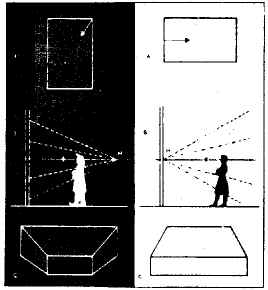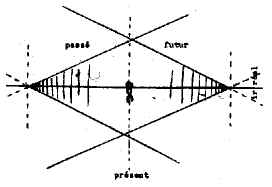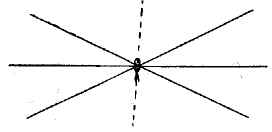|
|
Originality and Magnitude (on Isou's System)
Asger Jorn
Internationale Situationniste #4 (June 1960)
Translated by Fabian Tompsett
 Yesterday I told you I'd discovered the secret of eternal youth... But I was wrong — I got the cultures mixed up. Everything is as it was before, and I even wonder if it might be going against the laws of nature to want to prevent man from losing his youth... Yesterday I told you I'd discovered the secret of eternal youth... But I was wrong — I got the cultures mixed up. Everything is as it was before, and I even wonder if it might be going against the laws of nature to want to prevent man from losing his youth...
|
In No. 10 of Poésie Nouvelle (First Trimester, 1960), Isidore Isou, refuting the writings of one of his friends from a recent period, whom he soberly calls X in order not to give him unmerited publicity, declares:
One of the shabbiest lies of the author of Grammes is to speak of my general philosophical system when a) I have never published this system, and b) X is neither a prophet or cartomancer of the future.
If a number of my comrades who worked with me over the years, from Pomerand to Lemaître, have tried to divine the general system (and lacking the possibility they have at least the honesty to hold their tongue on this question), how could Z, who scarcely knows me, be able to know it?... The unique thing that Mr. Grammes could know of my intellectual order is that it accords to the creations of each domain an essential determined value, in relation to other values. But it is this which makes the successive X’s who, having known me, have no other supreme desire than to become creators. Thus the unique illumination that X has of my system ends at his conscious or unconscious effort to follow it, just when the ignorance of the whole of the system leads him to the real incapacity to create and the obligation to replace this creation with the tittle-tattle and lying pretensions about that which he knows nothing...It is only by accepting the creative hierarchy of the only movement of the contemporary avant-garde — given the general name ‘Lettrism’ — by candidly assimilating the innovating truth of the immediate past and present, by openly recognizing the forms of future evolution of the aesthetic disciplines that will truly be born for the history of culture and for the place of each author in this history. (Italics by A.J.)
Isou’s argument is constructed around a fundamental error according to which the knowledge of a system is only possible after you have become acquainted with all the consequences of the system; an idea which is pushed to the extreme by revealing the system through the testimony of the initiatory individual account, and the importance given to the particular usage that the master can make of his own system. In fact the system is a method. It is the method of the co-ordination of positions, of states. And, as the positions don’t change, the system, or the positional methods, are always revealed by analyzing a combination taken at random in the system.
Isou’s system is not a scientific system, as there are no longer any scientific systems. If Isou’s system had been a scientific system, it could not be ‘Isou’s system’, but only the application of the system by Isou in a given domain. Isou’s system necessitates Isou. It is a system of relations between subject and object. This system is an outlook. You don’t have to be a prophet or a cartomancer to work that out; you just have to be completely detached. I don’t know Isou, and I’m starting to be acquainted with his system. The order in which he arranges historic events is an extremely amusing and interesting thing, perfectly new in the European outlook: he measures all values according to Chinese perspective, just as values have been measured according to a central perspective since the renaissance.

Chinese Perspective and Western Perspective (the arrow in the rectangle indicates the normal path of the gaze).
It is today a well known fact that time is a dimension like any other, to be treated like those of space. Existentialism is opposed to the classic system by pretending that the instant is a unique value. Isou opposes this by establishing a little range of values between the immediate past and the present (which today is Isou). Isou is placed as a magnitude in his own perspective. Those who go in for this, with the obligatory slowness of followers of what has already been made by Isou, are smaller, and diminish from Lemaître to Pomerand, to finally arrive at the zero point, where we find the poor Mr X, who according to Isou’s system, is the nothing of everything, the nullity, the historic non-place (but this is the historic non-place of the historic space of Isou, which explains the importance Isou gives to the repeated description of this nothingness, this personification is anonymous). If the lines of perspective are prolonged beyond the zero point, history is expanded once again towards the pre-Isouian past, and the more the magnitudes are expanded in the past, the more they are accepted by Isou without criticism, and characterized according to their awkwardly scholastic reputations (Homer, Descartes etc.). This is the hierarchic order of Isou as regards the past; and as regards the future, where in any case he reckons a central creative place will come to be recognized for eternity, he will expect that an even greater system will replace it, and at the same time confirm it. “In order to better establish the possibilities of the preservation of a section of the avant-garde,” he goes along with the Breton’s famous formula about “the birth of a more emancipatory movement”. Nothing is more comfortable than to wait for successors, because the succession is not passed on by a direct line, but through contradiction.

Isou's Chinese Perspective.
Having thus clarified Isou’s system of valorization, an essential problem must now be posed: is it more of a religious system than an artistic one? It must be because he is unable to make a decision on this point that Isou has not yet published the final word in his system. From reading the development of his thought from the accessible material, it seems that there can be discerned a slippage by which the religious and cultural side more and more replace the artistic; hierarchic aspect becomes more important than the movement of Chinese perspective.
In order to be
oriented, and from this fact to
calibrate, in any particular dimension, it is always necessary to find a zero point, the point of departure or origin, whence proceeds all graduation. But the question is posed here: is Isou’s zero point fixed in history in the same way that the birth of Christ is fixed as the origin of our calendar. Isou thus becomes forever greater as he moves forward in time. Equally, is his Chinese perspective historically displaced through time? In this case, Isou will come to be diminished more and more in order to become the zero point of a new avant-garde, and only afterwards will he accede to the aggrandisement of the past. Thus the question is restated: could Isou’s system be employed as a method by others? This would increase the importance of the system, but must then diminish the importance of his personage. The impression is that it would benefit from two advantages, but this is impossible without the whole unhappy system being destroyed and renewed. This eventuality cannot be theoretically excluded. Isou was close to such a discovery in his recent reflections on prodigality, by which he found himself obliged to recognise the superiority of the situationist practices over the lettrist system. The unresolved problem on this religious question, and the double game which necessarily arose from it, has contributed to the very quick dissolution of the avant-garde gathered around Isou circa 1950. This is found, degraded to farce in the eternal discussion of Isou with Maurice Lemaître who for years constituted Isou’s ‘lettrist group’ all on his own (cf. the same issue of
La Poésie Nouvelle).

The Dual Perspective of Classical Europe.
The disaster of Isou’s system is to place the zero point as
a divine point in the past, as much as placing himself as a sacred object. It is not by chance that the Chinese perspective is found in an ideology secretly held by Buddhism. In contrast, the classic system places the divine zero point at the center of the perspective of the future, and the sacred in the anti-world radiating towards infinity, beyond the extreme point of reality. The artistic bearing is a systematization of facts which themselves ignore the system. When this is unveiled, established, the artistic value is always pursued elsewhere (the innocent vision is inverted in principle). In the same way as the rich ‘lettrist’ researches (in the common sense of the word) of manuscripts from the end of the middle ages have been eliminated by printing (quantitative distribution of writing through the elimination of variations), so the lucky find, by the renaissance, of the central perspective has radically finished Christian art, of which the variables were eliminated by this organisation-type of Christian space. In effect, the central perspective, if it is transposed onto the dimension of time, exactly represents Christian metaphysics, the beyond being in the imaginary future, marked out by two successive points: death and Judgement Day. The utopians had places their perspective
on the earth (in the historic future), and the artistic inspiration of modern times is essentially a futurist utopianism.
Isou’s Chinese perspective could therefore be compared to the Me-zero (divine-sacred identity) perspective, the outlook of radiating subjectivity of Vilhelm Bjerke-Petersen, so typical of Scandinavian thought. The advantages of Isou’s system can be seen on this terrain. In the end, a modern perspective could be invoked which considered the qualitative development of magnitude. This is the purely scientific outlook, characterised by its point of origin in the past, the zero point at the beginning of time. In this outlook that we actually find confirmed at the cosmic level with the theory of the expanding universe. Scientific socialism is linked to this outlook. But overall this question is so vast because there are many outlooks which have now been created.

V. Bjerke-Petersen's Perspective (the mystical optics of the past-present-future identity)
Isou’s
religious problem is complicated by a perplexity on the following theme: “I am god, seeing as how god is youth; seeing as how I am Isou, the point of origin”. He must choose between personal originality and that of the system which he has created and which automatically excludes him from the sphere of originality at the end of youth. The reservations which Isou has as regards his own system are easily explained. He is ageing, my friend!
The divinisation of the immediate past is
the divinisation of the aged (the older generation), which is associated, through the dynamic use of Isou’s Chinese perspective, with his concept of
holy youth. (“We start a career...”). Thus the aged Isou sees the new youth start to overthrow him in virtue of his own system, and he flees to a more assured place, protected by the books of Breton. The drama unfolds, it’s simply that Lettrism has superseded surrealism. In this way it will retire to claim its part in literary immortality. What gaiety! Holy youth! It returns all the time, and it is always the same. I exposed this gimmick in
La Roue de la Fortune in 1948.
It is time to become aware of the drawbacks of all the systems of perspective derived from classical geometry. Many errors arise from a major illusion of modern savants: a distinction between ‘classical’ and ‘modern’ geometry was made in the belief that the autonomy of classical geometry could be saved, and that it could be taught as geometry and that which had superseded it were simultaneously true. In the geometry of Euclid, and this has been transmitted to the non-Euclidean systems,
the point is defined as a spatial location with no spatial dimension. This omits the fact that the point, bereft of spatial dimensions, still represents the temporal dimension, thanks to its duration. The point thus introduces the dimension of time into spatial organisation, which is the basis of a new elementary geometry. (It is this new study of the point which enables the situation to be understood as a spatial-temporal work alien to the old properties of art). When the point is considered as a pure idea, geometry is infected with metaphysics and lends itself to the emptiest constructions of metaphysics. Nothing is left of it.
Human creation does not resemble this sort of French garden, such as Isou would want to embellish, the centre of which he believes he will come to
definitively occupy, simply because, preaching untiringly in the emptiness, he foresees (in his own words, ‘the opening of a new amplic’) the completely
symmetrical reproduction of the other side of Isou.
|

 Yesterday I told you I'd discovered the secret of eternal youth... But I was wrong — I got the cultures mixed up. Everything is as it was before, and I even wonder if it might be going against the laws of nature to want to prevent man from losing his youth...
Yesterday I told you I'd discovered the secret of eternal youth... But I was wrong — I got the cultures mixed up. Everything is as it was before, and I even wonder if it might be going against the laws of nature to want to prevent man from losing his youth...


